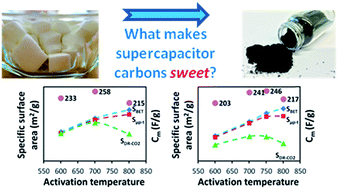Activated carbons (ACs) are actively researched as electrode materials for supercapacitors and there is a significant interest to produce ACs from sustainable and low cost precursors. In this study, various ACs were prepared from hydrothermally carbonized sugars by KOH activation. Both the hydrothermal carbonization and activation processes were optimized to tailor the properties (e.g. textural properties, chemical composition, N-doping, electrical conductivity) of the ACs. For instance, the Brunauer–Emmett–Teller (BET) surface areas (SBET) were tuned in the range of 800–3000 m2 g−1 with associated variation in the extent of microporosity and pore size distributions (PSDs). The ACs were evaluated electrochemically as materials for supercapacitor electrodes in a symmetrical two-electrode cell using an aqueous electrolyte. The relationship between the electrochemical, textural, electrical, and physicochemical properties were analyzed systematically to understand the key factors determining the electrochemical performance. A high specific capacitance (Cm) of ∼260 F g−1 was achieved at a moderately high SBET of ∼1300 m2 g−1, which was equivalent to a Cm/SBET of 20 μF cm−2, for an optimal AC prepared from hydrothermally carbonized glucose. The very high surface-specific capacitance highlights that the specific surface area is certainly not the sole limiting parameter for effective electrode materials.

